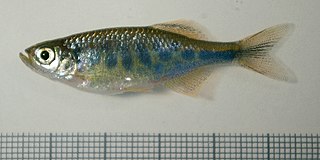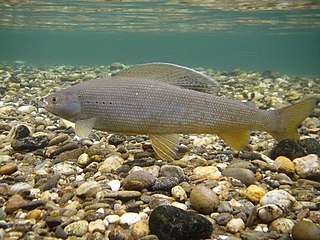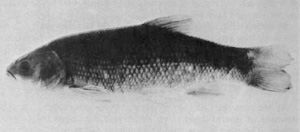
The Chao Phraya River is the major river in Thailand, with its low alluvial plain forming the centre of the country. It flows through Bangkok and then into the Gulf of Thailand.

Devario is a genus of fish in the family Cyprinidae native to the rivers and streams of South and Southeast Asia. These fishes have short barbels and many species having vertical or horizontal stripes. These species consume various small, aquatic insects, crustaceans and worms, as well as, in the case of fry, plankton.

The Arctic grayling is a species of freshwater fish in the salmon family Salmonidae. T. arcticus is widespread throughout the Arctic and Pacific drainages in Canada, Alaska, and Siberia, as well as the upper Missouri River drainage in Montana. In the U.S. state of Arizona, an introduced population is found in the Lee Valley and other lakes in the White Mountains. They were also stocked at Toppings Lake by the Teton Range and in lakes in the high Uinta Mountains in Utah, as well as alpine lakes of the Boulder Mountains (Idaho) in central Idaho.

The thicktail chub was a type of minnow that inhabited the lowlands and weedy backwaters of the Sacramento and San Joaquin Rivers in the Central Valley of California. It was once abundant in lowland lakes, marshes, ponds, slow-moving stretches of river, and, during years of heavy run-off, the surface waters of San Francisco Bay. The thicktail chub was one of the most common fish in California. Within Native American middens it represented 40% of the fish.
Devario browni is a species of fish in the family Cyprinidae found in fast-flowing, shaded streams in the Salween River drainage; it feeds mainly on terrestrial insects, including ants and flies.

The Arctic cisco, also known as Arctic omul, is an anadromous species of freshwater whitefish that inhabits the Arctic parts of Siberia especially Yenisey Gulf. It can also be found in Alaska and Canada. It has a close freshwater relative in several lakes of Ireland, known as the pollan, alternatively regarded as conspecific with it, or as a distinct species.

Salmo obtusirostris, commonly known as the softmouth trout, also known as the Adriatic trout, or Adriatic salmon, is a species of salmonid fish endemic to a handful rivers spilling into Adriatic in the Western Balkans, in southeastern Europe, namely in Bosnia and Herzegovina, Croatia and Montenegro. The scientific name has changed several times through history; synonyms include Thymallus microlepis, Salmothymus obtusirostris and Salar obtusirostris.

The Oregon chub is a species of ray-finned fish in the family Cyprinidae. It is endemic to Oregon in the United States. From 1993 to 2015 it was a federally listed threatened species.Their scales are relatively large, with less than 40 on their lateral line. The scales towards the caudal fin are outlined with a darker pigment.

The humpback whitefish, also referred to as the bottom whitefish, the Arctic whitefish or the pidschian, is a species of freshwater whitefish with a northern distribution. It is one of the members in the broader common whitefish complex, or the Coregonus clupeaformis complex. This fish lives in estuaries and brackish water near river mouths, in deltas and in slowly running rivers, in large lakes with tributaries, and floodplain lakes. It can migrate long distances upriver for spawning.
Microsynodontis nasutus is a species of upside-down catfish endemic to Gabon where it occurs in the Ogowe River. It was first described in 2004 by Ng Heok Hee.
Hypsibarbus birtwistlei is a species of ray-finned fish belonging to the family Cyprinidae, the family which includes the carps, barbs, minnows and related fishes. This fish is found in forest streams and rivers in Peninsular Malaysia and Sumatra.
Goldfin tinfoil barb is a species of cyprinid fish that is found in Southeast Asia. It is native to the countries of Cambodia, Laos, Malaysia and Thailand where it is used as a food fish and in the aquarium trade.

Hypsibarbus is a genus of cyprinid fish that is found in freshwater in Mainland Southeast Asia, including the Thai-Malay Peninsula.
Hypsibarbus lagleri is a species of ray-finned fish in the genus Hypsibarbus which is endemic to the middle Mekong basin in Cambodia, Laos and Thailand. It is fished for as a food fish and marketed fresh.

Hypsibarbus pierrei is a species of freshwater ray-finned fish in the genus Hypsibarbus native to rivers in Mainland Southeast Asia.

Hypsibarbus salweenensis is a species of ray-finned fish in the genus Hypsibarbus which is endemic to the Salween River system in Myanmar and Thailand.
Hypsibarbus suvattii is a species of ray-finned fish in the genus Hypsibarbus which has only been recorded with certainty from the Mae Klong in Thailand. It is a big-sized cyprinid, reaching 50 cm (19 in) SL, but it is rare species. The specific name honours Thai ichthyologist Chote Suvatti, former professor of Kasetsart University, who is one of the pioneers of fisheries in Thailand.

Hypsibarbus vernayi is a species of cyprinid fish in the genus Hypsibarbus. The specific name references Arthur S. Vernay, an English adventurer who collected the type specimen.

The greenfin darter is a species of freshwater ray-finned fish, a darter from the subfamily Etheostomatinae, part of the family Percidae, which also contains the perches, ruffes and pikeperches. It is endemic to the eastern United States.
Hypsibarbus oatesii is a species of freshwater ray-finned fish from the carp and minnow family, the Cyprinidae. It is found in the southern Shan Hills in Myanmar in the Salween River. It is caught for food in subsistence fisheries. The specific name honours Eugene William Oates who collected the type specimen.












